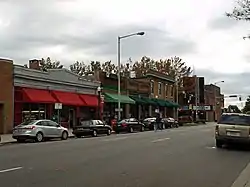Fourth Avenue Historic District (Birmingham, Alabama)
The Fourth Avenue Historic District in Birmingham, Alabama was listed on the National Register of Historic Places in 1982. The listing included 17 contributing buildings on 4.2 acres (1.7 ha). It includes the 1600-1800 blocks of 4th Ave., N. and part of the 300 blocks of 17th and 18th Sts., N.[1]

Fourth Avenue Historic District | |
 | |
 | |
| Location | 1600-1800 blks of 4th Ave. N and part of the 300 blks of 17th and 18th Sts. N, Birmingham, Alabama |
|---|---|
| Area | 4.2 acres (1.7 ha) |
| Architect | Persley, Taylor E.; Woods, Walter T. |
| Architectural style | Art Deco, Victorian commercial |
| NRHP reference No. | 82002041[1] |
| Added to NRHP | February 11, 1982 |
One reason that it was deemed significant is that the district "is the only place left in the city which tells the story of the Jim Crow years in Birmingham (1908-1941). Prohibited from patronizing white restaurants, movie theaters, and personal service establishments, blacks developed businesses in those areas to serve their community. They also offered professional services (medical and legal) to the black community. Although now somewhat diminished by the demolition of some structures and the dispersal of black life that has come with integration and suburban expansion, important structures remain which document what was once the center of commercial activity in black Birmingham."[2]
It includes works by architects Taylor E. Persley, Walter T. Woods and others. It includes Art Deco architecture and Victorian commercial architecture.
It includes:
- Alabama Penny Savings Bank, aka Pythian Temple, which was already separately listed on the National Register.
- Colored Masonic Temple, a seven-story building[2]
References
- "National Register Information System". National Register of Historic Places. National Park Service. November 2, 2013.
- Ann M. Burkharrdt (August 1981). "National Register of Historic Places Inventory/Nomination: Fourth Avenue Historic District". National Park Service. Retrieved July 25, 2019. With accompanying 11 photos from 1977 and 1980
| Wikimedia Commons has media related to Fourth Avenue Historic District (Birmingham, Alabama). |
